The mission statement for High Trails that is prominently displayed on all of the shirts we wear around is “Learning how we can all fit together on one healthy planet”. I believe that for all of us to fit together on this here Earth, we need to grow.
Fit together by growing? Sounds a little backwards doesn’t it?
Well, I’m not talking about physical growth, but rather all the other ways we can grow. It’s easy to see that we put an emphasis on growing the minds of our youth intellectually, teaching them the curriculum that is required for them to progress through school. But what’s often overlooked is the effort we put into helping kids grow mentally, emotionally, socially, and more. And some of that growth starts by choosing to challenge ourselves.
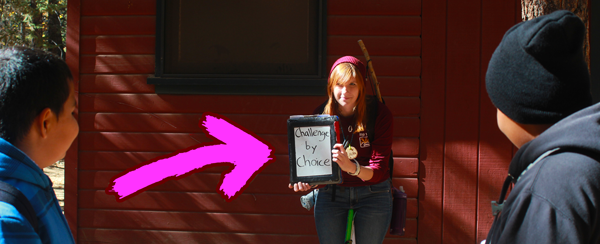
Challenge by What?
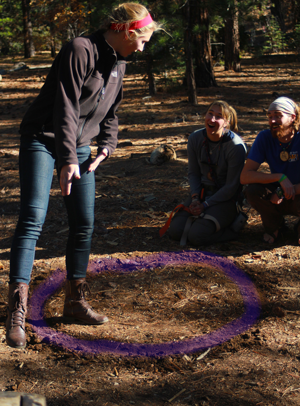 The Adventure Course and Rock Climbing are two of our classes that have a distinct detail in the lesson plan that no other classes have: Challenge by Choice. Challenge by Choice means that students have a choice as to how much they want to challenge themselves, how far they want to push their comfort zones. This simple phrase means a whole lot, and it has much to do with comfort zones.
The Adventure Course and Rock Climbing are two of our classes that have a distinct detail in the lesson plan that no other classes have: Challenge by Choice. Challenge by Choice means that students have a choice as to how much they want to challenge themselves, how far they want to push their comfort zones. This simple phrase means a whole lot, and it has much to do with comfort zones.
The first thing I do in each of these classes is draw a circle in the dirt. This circle represents your comfort zone, I tell my students. Do we all have the same size comfort zone? No. Is that okay? Yes.
What we’re trying to do today is inch our toes right to edge of our own comfort zones, right to the point where we want to say, “That’s it, I’m done, I can’t go any further.” And then…
And then, we take one step further. Because after we take that step, we’ve entered unchartered territory. Our comfort zone is now bigger. And that’s what we call growing.
Where does the Growing Happen?
The growing of comfort zones is most obvious at the climbing wall. A student will climb partially up the wall, come to a difficult point, stop, and proceed to utter that oh so common phrase, “I want to come down.” This is where the instructor must make a judgment call.
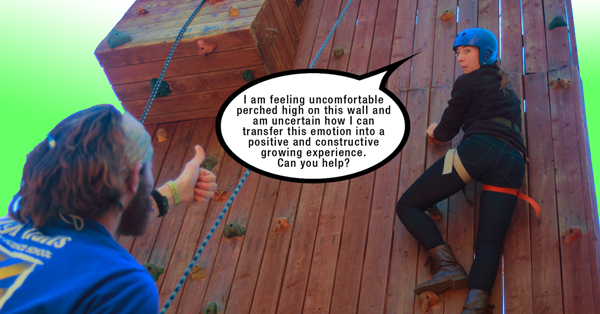
If they sense the student is still within their comfort zone, the next move should be to encourage that student to take one more step up that wall. However, if the student is clearly already outside their comfort zone, it can be dangerous to push them too far. We’ll get to that farther down the page.
Forbes Says You Should Step Outside The Circle
 Forbes magazine came out with an article earlier this year featuring a Senior Director at Wal-Mart who talked about 6 benefits of stepping outside your comfort zone. 1
Forbes magazine came out with an article earlier this year featuring a Senior Director at Wal-Mart who talked about 6 benefits of stepping outside your comfort zone. 1
- You will let perfection go.
- You will inspire others.
- You will have no regrets at the end.
- You will define yourself.
- You will gain control.
- Your life experience will be fuller.
Forbes and Wal-Mart may be a far cry from the forest, but they are still very successful businesses and have lots of lessons to teach.
A 100+ Year Old Experiment Says Step Outside The Circle
 In 1908, psychologists Robert M. Yerkes and John D. Dodson discovered that a state of relative comfort creates a steady level of performance. 2 Meaning if you always do what you’ve always done, you’ll always get what you’ve always got.
In 1908, psychologists Robert M. Yerkes and John D. Dodson discovered that a state of relative comfort creates a steady level of performance. 2 Meaning if you always do what you’ve always done, you’ll always get what you’ve always got.
In order to improve performance, we need to be in a state of “relative anxiety”, a state of mind where our stress levels are higher than normal. We call this state of mind, “Optimal Anxiety”, and it happens to reside just outside of our comfort zone. Stepping into this state of “Optimal Anxiety” is where growth happens.
Too much anxiety, however, caused by stepping too far outside our comfort zones, can be detrimental to our performance because we are too stressed to be productive. This is where a good sense of judgment comes in, and the instructor must decide whether pushing a student will be productive or counter-productive.
Too little anxiety means no growth. Too much anxiety means no peace.
Our Muscles and Brain Say You Should Step Outside The Circle
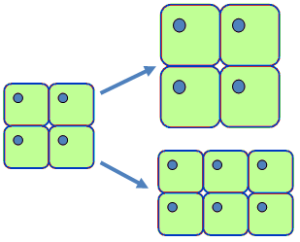 Do you know how muscles on our body grow? First we push them with exercise to the point that they feel tired. Then we rest and eat food. And then our muscles grow bigger…Muscle Hypertrophy. 3
Do you know how muscles on our body grow? First we push them with exercise to the point that they feel tired. Then we rest and eat food. And then our muscles grow bigger…Muscle Hypertrophy. 3
Same thing might just happen with our brain. Studies done by neurobiologists at the University of California at Irvine suggest that direct change and manipulation of our brain cells intiates the learning and growing process. One brain cell becomes 2 brain cells. 2 brain cells become 4 brain cells. Keep repeating. 4
Now What?
Remember our goal of “Learning how we can all fit together on one healthy planet”?
Many of the students we see up here are used to spending a lot of time inside, by themselves, and using their technological devices. This doesn’t always lend itself to us learning to get along with each other or the environment.
While we have no scientific studies to prove it, our personal observations and our end of the week written evaluations show that students who attend High Trails are more comfortable with themselves and the environment around them.
This wouldn’t happen if we didn’t push our students. Although they may be resistant to change and growth at first, they’ll thank their instructors at High Trails Outdoor Science School one day for pushing them to be better human beings.
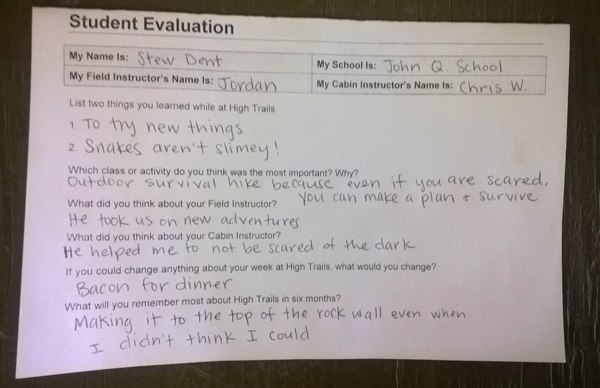
At High Trails Outdoor Science School, we literally force our instructors to write about elementary outdoor education, teaching outside, learning outside, our dirty classroom (the forest…gosh), environmental science, outdoor science, and all other tree hugging student and kid loving things that keep us engaged, passionate, driven, loving our job, digging our life, and spreading the word to anyone whose attention we can hold for long enough to actually make it through reading this entire sentence. Whew…. www.dirtyclassroom.com
- http://www.forbes.com/sites/kathycaprino/2014/05/21/6-ways-pushing-past-your-comfort-zone-is-critical-to-success/ ↩
- http://psychclassics.yorku.ca/Yerkes/Law/ ↩
- http://www.expert-nutrition.com/muscle-hypertrophy.html ↩
- http://www.bio.uci.edu/2013/09/uci-led-study-creates-new-memories-directly-changing-brain/ ↩

Comments are closed.